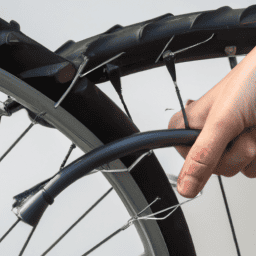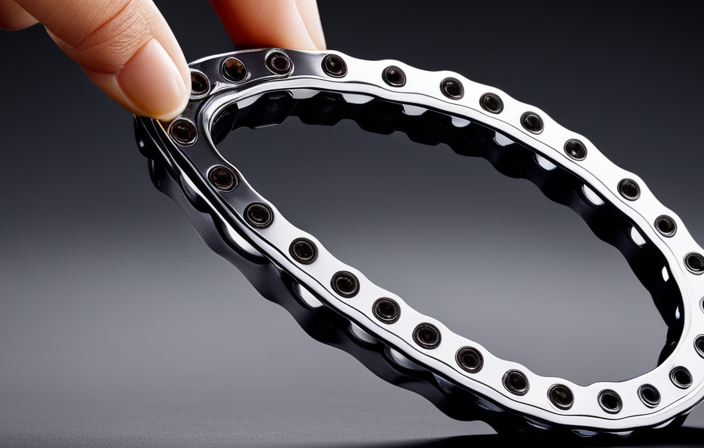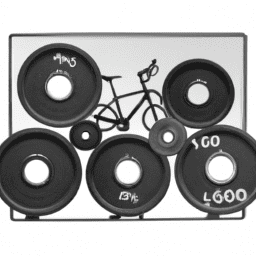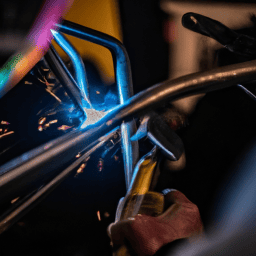Were you aware that the primary cause of a flat bicycle tire is a punctured inner tube? Indeed, a survey carried out by the League of American Bicyclists reveals that 90% of flat tires result from punctured inner tubes.
But don’t let a flat tire ruin your ride! With a few simple steps, you can easily change your bicycle’s inner tube and get back on the road in no time.
In this article, I will guide you through the process of changing a bicycle’s inner tube. Whether you’re a seasoned cyclist or a beginner, this skill is essential for any rider. Not only will it save you time and money, but it will also give you the confidence to tackle any unexpected flat tire on your own.
So, let’s get started!
Key Takeaways
- Changing inner tubes is an essential skill for any rider
- Proper inflation is key to a smooth and safe ride
- Tube patching can be a useful skill in case of a puncture
- Always take safety seriously and follow proper procedures, as hazards include getting fingers caught in the chain or hit by a passing car.
Identify the Problem
So, you’ve got a flat tire on your bike, huh? Don’t worry, it’s a common problem that can happen to anyone.
The first step in fixing a flat tire is to identify the problem. Inspecting the damage is the first thing you should do. Check the tire for any visible tears, cuts, or damage.
Next, locate the puncture source by running your fingers around the inside of the tire to feel for anything sharp that may have caused the puncture. Once you’ve found the puncture, mark it with a pen or chalk so you can easily locate it later.
Now that you’ve identified the problem, it’s time to remove the old tube. Without delay, let’s move on to the next step, which is removing the old tube.
Remove the Old Tube
First, you’ll want to deflate the tire completely by pressing down on the valve stem with your thumbs and turning it counterclockwise. It’s important to use the proper tools when removing the old tube to avoid damaging the tire or rim. I recommend using tire levers to pry the tire away from the rim, starting at one side and working your way around.
Be careful not to use too much force and pinch the tube between the tire and rim. Safety precautions should also be taken when removing the old tube. Wear gloves to protect your hands from any sharp edges on the rim or tire, and inspect the tire for any debris or damage that may have caused the flat.
Common causes include punctures from sharp objects like glass or thorns, or wear and tear from regular use. Once the tire is removed, carefully remove the old tube and inspect it for any holes or damage before discarding it. Now that the old tube is removed and inspected, it’s time to install the new tube.
Install the New Tube
To install the new tube, you’ll want to start by lining up the valve stem with the hole in the rim, and then tucking the rest of the tube inside the tire.
Make sure that the tube is not twisted or caught between the tire and the rim, as this could cause the tube to puncture once it’s inflated. It’s a good idea to add a small amount of air to the tube before fully installing it, as this will help to prevent it from getting pinched or caught between the tire and the rim.
There are different types of inner tubes available, so make sure that you choose the right one for your bike. You can find the right size by checking the sidewall of your tire, which will have the tire size and recommended tire pressure printed on it.
Proper inflation techniques are also important to prevent punctures and other problems. Be sure to inflate the tire to the recommended pressure using a pump with a pressure gauge, and check it regularly to make sure that it stays at the right pressure.
With the new tube installed, it’s time to reassemble the wheel.
Reassemble the Wheel
Now that I’ve installed the new tube, it’s time to reassemble the wheel.
I’ll start by putting the wheel back on the bike, making sure it’s properly aligned and tightened securely.
Next, I’ll adjust the brakes to ensure they’re functioning properly and the wheel is able to spin freely without any rubbing.
It’s important to take the time to do this step correctly to ensure a safe and smooth ride.
Put the wheel back on the bike
As the wheel slides smoothly into place, a sense of relief washes over me like a cool breeze on a hot day. Before I tighten the bolts, I double-check to ensure proper alignment. I make sure that the wheel sits straight and that there is enough clearance between the brake pads and the rim. Once I am satisfied with the alignment, I use the tightening techniques I learned earlier to secure the bolts. I tighten them in a crisscross pattern, ensuring that each bolt receives an equal amount of torque. I also avoid common mistakes, such as over-tightening or cross-threading the bolts, which could damage the wheel and make future repairs more difficult. Finally, I take safety precautions by wearing gloves and avoiding loose clothing that could get caught in the chain or wheel.
To reinforce the importance of safety, I created a table to outline the potential consequences of not following proper safety procedures while changing a bicycle inner tube. On one side of the table, I listed common safety hazards that could occur, such as getting fingers caught in the chain or getting hit by a passing car while working on the bike. On the other side, I listed the potential consequences of these hazards, such as losing a finger or suffering a serious injury. This table serves as a reminder to always take safety seriously and to follow proper procedures when working on a bike.
As I move on to the next step of adjusting the brakes, I am confident in my ability to change a bicycle inner tube safely and effectively.
Adjust the brakes
After successfully putting the wheel back on the bike, the next step is to perform brake maintenance by adjusting the cable tensioning. Properly adjusted brakes ensure optimal performance and safety while riding.
To begin, locate the brake cable adjuster, which is usually found on the brake lever or caliper. Next, turn the adjuster clockwise to tighten the cable and increase the brake’s stopping power. Alternatively, turn the adjuster counterclockwise to loosen the cable and decrease the brake’s stopping power. It’s important to make small adjustments and test the brakes frequently to avoid over-tightening or over-loosening.
Once the desired level of tension is achieved, test the brakes by squeezing the brake lever and observing the brake pads make even contact with the wheel rim.
Brake maintenance is an essential part of bicycle upkeep, and cable tensioning is a crucial component of brake adjustment. By following these steps, you can ensure that your brakes are properly adjusted for optimal performance and safety.
The next section will cover how to test and adjust your brakes to ensure they’re working correctly.
Test and Adjust
Well, isn’t it just delightful that we get to test and adjust our newly installed inner tube before hitting the road? Testing and adjusting the inner tube is an important step to ensure the safety and functionality of your bicycle. The two main things to consider when testing and adjusting are proper inflation and tube patching.
Firstly, proper inflation is key to a smooth and safe ride. Underinflated tires can cause more rolling resistance, making it harder to pedal and slowing you down. Overinflated tires can be dangerous as they increase the risk of a blowout while riding. Refer to the table below for recommended tire pressures based on tire width. Use a tire pressure gauge to measure the pressure in your tires and adjust accordingly.
| Tire Width | Recommended Pressure |
|---|---|
| Up to 23mm | 100-130 psi |
| 25-28mm | 90-110 psi |
| 30-32mm | 75-95 psi |
| 35-40mm | 50-70 psi |
| 44-50mm | 30-50 psi |
Secondly, tube patching is a useful skill to have in case of a puncture. Before testing the tube, check for any visible punctures or leaks. If there are any, patch the tube before inflating it. Refer to the instructions on your tube patch kit for proper patching techniques. Once patched, inflate the tube to the recommended pressure and check for any additional leaks by submerging it in water. If there are no leaks, you are ready to re-install the tire onto the rim. By properly testing and adjusting your inner tube, you can have a safe and enjoyable ride.
Frequently Asked Questions
What is the difference between a Presta and Schrader valve, and which one should I use for my bike?
When deciding between a Presta and Schrader valve, consider the pros and cons. Presta valves are lighter, require a smaller hole in the rim, and are commonly used on road bikes. Schrader valves are more durable and easier to find replacement tubes for. Properly inflating tires with different valves involves using the correct pump head and adjusting the pressure accordingly.
How do I know if my inner tube needs to be replaced, and how often should I replace it?
I know it can be hard to tell when it’s time to replace your inner tube, but signs of wear include frequent punctures and bulges. A good rule of thumb is to replace your tube every 2-3 years to ensure optimal performance.
Can I patch a punctured inner tube, or do I need to replace it entirely?
When dealing with a punctured inner tube, the decision to patch versus replace depends on the size and location of the puncture. A patch is a cheaper DIY option, but a professional replacement may be necessary for larger or multiple punctures.
What tools do I need to change an inner tube, and can I use household items as substitutes?
As a beginner, using household items as substitutes for inner tube change tools is possible but not recommended. It’s important to invest in the right tools for safety and efficiency. Remember to loosen the brakes before removing the wheel.
How do I prevent getting a flat tire in the first place, and what are some common causes of flat tires?
To avoid flat tires, regularly check tire pressure and inspect tires for debris or wear. Common causes of punctures include sharp objects on the road and underinflated tires. Avoid riding over debris and maintain proper tire pressure to reduce the risk of flats.
Conclusion
After successfully changing my bicycle’s inner tube, I can confidently say that it’s not as daunting of a task as it may seem. It requires patience, focus, and attention to detail, but the feeling of accomplishment once the job is done is worth it.
As I reassembled the wheel and tested it out, I felt a sense of satisfaction and pride. The smooth rotation of the tire and the absence of any leaks boosted my confidence as a cyclist.
It’s important to remember that changing an inner tube is a necessary skill for any rider, and with practice, it becomes easier and quicker.
So, if you find yourself with a flat tire while out on a ride, don’t panic. Take a deep breath, follow the steps outlined in this guide, and you’ll be back on the road in no time.
And who knows, you may even find that the experience of changing a tube adds to the enjoyment of cycling, as you become more self-sufficient and confident in your abilities. Happy riding!









